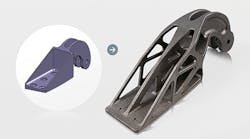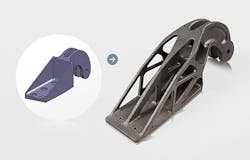Is 3-D printing greener than conventional manufacturing? It’s one of the many questions about this disruptive technology that is being explored. While 3-D printing or additive manufacturing typically uses less material than other processes to produce a part, the process itself can be energy intensive as it frequently involves melting a material at high temperature.
Just the manufacturing process used to produce a part doesn’t tell the whole sustainability story, however. Environmental assessments become more useful as they encompass the full lifecycle of a product, from obtaining the material to manufacturing to use and ultimately reuse or disposal.
Airbus Group Innovations and EOS, a 3-D printing company, recently conducted an environmental comparison between a conventional steel Airbus A320 nacelle hinge bracket and a titanium bracket produced using direct metal laser sintering (DMSL).
Airbus and EOS then compared production of a titanium bracket using both rapid investment casting and additive manufacturing. They found that the additive manufacturing offered a slight advantage in energy consumption. However, the consumption of the raw material in 3-D printing was up to 75% less than with casting.
While EOS cautioned that it hadn’t looked yet at the issue of scalability, it said the test demonstrated the potential for reducing the weight of the plane by 10 kilograms – “a noteworthy figure in aviation where every kilo counts.” By optimizing the bracket design, it found, CO2 emissions were reduced by almost 40% during the lifecycle of the part.
“In general, the joint study revealed that DMLS has the potential to build light, sustainable parts with due regard for the company’s CO2 footprint,” said Jon Meyer, Airbus’ additive layer manufacturing research team leader.





